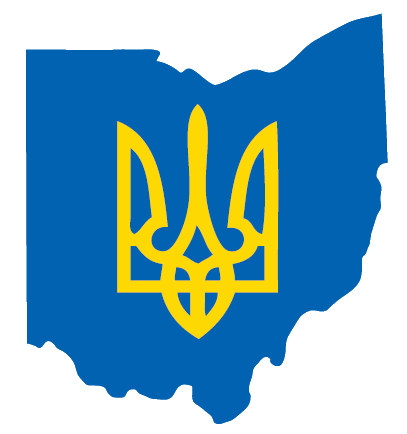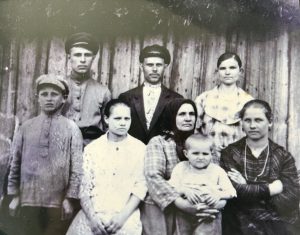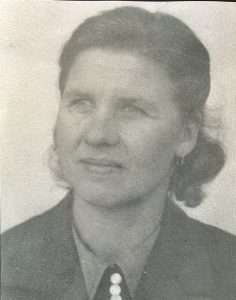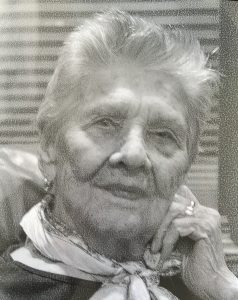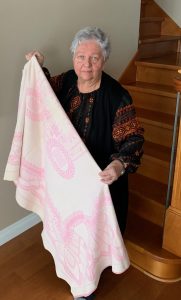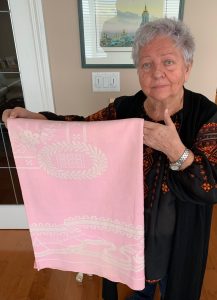
- This event has passed.
Holodomor Awareness Presentation: Babusia’s Blanket
November 8, 2022 - November 12, 2022
November 7th-11th: “Babusia’s Blanket”
Sonia Lebedin recounted a personal story of the Holodomor as experienced by her mother, a Holodomor survivor. She shared her story virtually with a history class at Bakersfield College (California), a Ukrainian culture class at OSU (in person, here in Columbus), a college classroom virtually in Tuscon, Arizona, and then visited fourth and fifth grade classrooms at Summit Road Elementary in Reynoldsburg, OH as well as the International Baccalaureate classes at Dublin City Schools.
Sonia first presented the story of her mother’s experience during the Holodomor at a teachers’ conference in Winnipeg, Canada, after which many teachers reached out with the request to bring her presentation to their classrooms and share her story with their students.
We were delighted by the warmth and grace we met with in each classroom, and have great hope that the story of this blanket touched all of these students and teachers, linking the truth of the Holodomor to present day events in Ukraine.
Special thank you to Alicia Baca at the Center for Slavic and East European Studies at the Ohio State University for promoting this opportunity to her network of educators, she made this series of events possible.
My Mother’s Coverlet / Babusia’s Blanket
Hello, my name is Sonia Lebedin. Thank you for inviting me to speak to you today.
My mother was a witness and a survivor of the Holodomor, the Ukrainian Famine Genocide of 1932-33. The word Holodomor is derived from the Ukrainian words “holod” meaning hunger and “mor” meaning murder. Murder by hunger. Many millions of men, women and children did not survive. The exact number is not known. After the famine was over, the census takers were shot; the results were never released. They must have been devastating. What is known, however, are the words of Joseph Stalin when speaking to Winston Churchill about his “great experiment.” He boasted the cost in lives was high. “Tens of millions” he said. We owe it to the innocent victims who were starved to death…never to forget.
This year marks the 90th year since this horrific tragedy occurred, as a result of deliberate policies implemented by Joseph Stalin and the Soviet Regime which encompassed Soviet Ukraine at that time. It is important to remember this especially today when Ukraine is fighting once again for survival against the same aggressor with the same intent to destroy the Ukrainian nation and its people. Putin has openly declared that there is no such nation as Ukraine. Anyone who has strong patriotic views is labeled a Nazi and must be destroyed. Ukrainians, as they have for thousands of years, simply want to be free and independent, and are fighting right now as we speak for this very precious right.
So here is a small part of my mother’s story which took place during the Ukrainian Holodomor.
Anna Milko was born into a large farm family in central Ukraine, the third youngest of seven children. Her father inherited a large farm because for several generations there were many daughters and only one son. The was passed to sons. Other families who had many sons had to divide their land many time and so some had smaller farms and some had hardly any land at all.
My grandfather was a gentle, soft-spoken, hard-working, well-respected man. He and his family worked hard on their farm and they lived well. The oldest children received good educations: there was an engineer, a land surveyor, and my mother dreamed of becoming a teacher. They loved music, played various instruments and had a family orchestra. They lived in harmony with their neighbors.
But then the Bolshevik Revolution happened in Russia and it spilled into Ukraine. A new government, new rules, were instated. Lenin and his successor Stalin decided to change the system according to Marxist Leninist principles. The cities are for the workers and the countryside is for the farmers. Country people were divided into classes: “bidniaks” were the poorest of the poor who had nothing, “seredniaks” were the middle poor, and the “kulaks” were the ones who had the most land and wealth. In reality, kulaks (or “kurkuls” in Ukrainian) were all simple farmers. The Bolsheviks planned an economy based on collective farms, that is everyone gave up their land and farm animals to the state and everyone became equal and everyone worked on this collective land and was paid an equal portion of whatever profits there were at the end of the season. Government officials had the authority to seize kulak land, shoot any resistors, deport them. Often entire families were sent to Siberian work camps, to the Far East. Many died. According to recently released data from Soviet archives, between 1930 and 1931 some 1.8 million people were deported, 1.3 million reached their destination. That means half a million died on the way. Of course many more died once they were dumped off from the cattle cars in the middle of wilderness in severe winter cold.
Stalin decreed that “kulaks were to be eliminated as a class.” They were branded “Enemies of the People.” During the process of collectivization anyone identified as a kulak was subject to humiliation, deportation, violent beatings, murder, formal execution. Children were taught in school that kulaks were to be hated, that they were responsible for al the troubles of society because they were greedy and despicable.
At first the definition of a kulak was anyone who used hired labor, owned a mill or creamery, or any kind of machine with a mechanical motor, rented out land or equipment, traded, lent money, received income from anything other than labor…
…by this last definition, any poor famer who sold any of his surplus goods at market could be branded a kulak.
Quotas were established. A certain number of kulaks were to be eliminated in a certain given period of time. They started running out of kulaks to deport. Local officials were given the right to add any other criteria for defining kulaks depending on local conditions to fulfill their quotas. A Soviet politician of the time, Grigoriy Zinoviev said in 1924 “we are fond of describing any peasant who has enough to eat as a kulak.”
It became against the law to be Ukrainian: to wear or even possess a Ukrainian embroidered shirt, to play the Ukrainian national instrument the bandura. It became a crime to be Christian. Churches were shut, priests were arrested, shot, deported to work camps. It was against the law to speak of famine, to say the word “holod.” Just like today in Russia, it is against the law to call Putin’s Special Military Operation in Ukraine a “war” for fear of arrest, beatings, incarceration. It is important to note that in preparation for this new system of government there was also a purge of writers, historians, poets, artists, professors, scientists, journalists and political leaders who expressed Ukrainian patriotism. They were arrested, deported, murdered, jailed, and silenced, so that they could not come to the defence of ordinary people who had no voice.
Stalin knew that Ukrainians were going to be a problem. They were much too independent and bent on democracy. He was intent on exterminating as many as possible by any means possible. That meant destroying their language, their culture, their way of life, and terrorizing whoever was left, into submission. He that bandura players, “kobzari” who travelled from town to town and reminded people of their history and shared the news from neighboring villages had to be eliminated. The plan was to call a convention for them.. they were called to Kharkiv in December 1930. They came from all over Ukraine, presented a wonderful concert and after it was over they were herded onto railway cars, driven to the outskirts, shot and thrown into already dug out ravines. Their instruments were burned. The burial place is Kozacha Lopan’, a recently liberated town not far from Kharkiv. On December 30, 1930 the bandura was officially declared an “enemy class” of instrument. They were forbidden to be made, only harmoshkas and balaikas were allowed.
And so, my grandfather and all his family were branded kulaks. He was arrested and hauled off to jail where they used many different methods to convince him to turn over his land and possessions to the collective farm. Meanwhile, his neighbors went to the authorities to vouch for him. They said “this man has never done anything wrong, he is honest and kind, when we worked for him he paid us well. When we had difficulties he always helped and never asked to be repaid.” They were told that if they stood up for him they would face the same fate.
My grandfather was beaten and tortured and finally murdered and his body was dumped in front of his home. My grandmother buried him and was forced to denounce him. The local police who murdered him would drop in and she was obliged to entertain them. And then that was not enough. Soon the family was evicted from their home, their belongings ransacked and looted. They scattered, traveling by night. My mother and her younger sister and brother couldn’t go to school. They lived in constant fear of being found out.
My mother was finally fortunate enough to get a job at a huge state farm (SovKhoz) by lying about her origins. She said she was an orphan, didn’t know her parents, had no family. This state farm was originally the estate of a truly wealthy landowner who had long ago left… immigrated perhaps to France or even America. There were many buildings on the property, besides the splendid house, there were barns and all kinds of farm machinery and barracks where many young boys and girls lived while they worked there. The girls had their own building with three tiers of bunk beds. She worked hard wherever they sent her, in the fields and sometimes in the kitchen. She said it was thanks to this state farm that she survived the famine. The food they had was sometimes so miserable and disgusting, but at least they ate something every day. Sometimes all they had was the head of a pig which they used to make soup. The girls would scrounge in the fields for edible weeds to make the soup thicker. And there was always a piece of black bread.
That year all the grain crop that was harvested (it was an excellent year, the harvest was very bountiful my mother recalled) was shipped away. That year Stalin flooded the world markets with wheat for a very low price which helped to cause the Great Depression in the West. American and Canadian grain farmers were devasted, they could not compete with the low-priced grain from the Soviet Union.
There is an interesting story about a delegation that came one day to this SovKhoz:
Suddenly, one day lovely clean white sheets, new pillows and blankets appeared for the bunk beds. A huge shipment of sumptuous food arrived: meat, vegetables, fruit and butter and brandy, wine and sugar and cream… and sparkling white table cloths and lovely dishes. The kitchen was ordered to prepare the meal and my mother was chosen to be one of the servers. She was outfitted in a smart uniform with apron and headpiece. Soon a convoy of black sedans arrived and out came a procession of important-looking dignitaries. They were escorted around the farm and the grand scale of the work these young people accomplished. They were given a grand tour. Then they were brought into the dining room and fed a delicious meal. Everyone guessed that these were likely politicians or business men from the West and they were very impressed with Stalin’s new system. As soon as they left the sheets and pillows and tablecloths and food disappeared, faster than they had appeared.
Meanwhile, the famine was in full swing in the neighboring hamlets and villages. Groups of activists were encouraging young farm workers to accompany them to “extract food” from the farmers living nearby. These bands went from house to house looking for whatever food the people had, to confiscate it, throw it on the ground and stomp it into the earth. They poked the ground with long metal spikes to find buried grain or potatoes the starving people tried to hide to save themselves from death. My mother was always invited to come along. She had to be very creative to find excuses not to go, and not to bring attention to herself.
Starving people would come to the state farm asking for work, begging for food. Often after eating just one meal, they would die.
Eventually it became common knowledge that in the two closest villages, Pokrovka and Nastenkivka, everyone had died out. And, as in so many other villages and towns where empty houses stood, the communist authorities brought in trainloads of new people from Russia. In this way we see a perfect example of ethnic cleansing.
Much information about the Holodomor has been uncovered since the dismantling of the Soviet Union. The truth was covered up by the ruthless regime by suppressing freedom, by punishing people for even saying the word “famine.” The Soviet government closed the borders and people could not travel freely. The perpetrators used many of the same methods they use today to suppress the truth: misinformation, propaganda, and lies. They had some help from despicable journalists like Walter Duranty from the New York Times who lived a posh life in Moscow and sent articles back to the USA denying that any famine existed. He knew the truth and lied anyway. He won a Pulitzer Prize for his reporting. There were, on the other hand, honest journalists like Gareth Jones and Malcolm Muggeridge who travelled into the Ukrainian countryside illegally and saw the heartrending truth. Gareth Jones was assassinated by Soviet agents for his reporting.
Even in the face of irrefutable evidence, to this day, Russia has not admitted or acknowledged the truth of the Holodomor. Just as Ukraine was a problem for Stalin in the 1930s, Ukraine is a problem for Putin today. Ukrainians are demanding freedom, human rights, and democracy: the very things that threaten Putin’s corrupt oligarchy. And so today, just as in 1932, there is another genocide of Ukrainians occurring. This time at the hands of Putin and the Russian Army. For the last 8 months they have been bombing cities, killing innocent civilians, destroying schools and hospitals, cultural heritage sites and stealing artifacts from museums in Ukraine. They are responsible for grain shortage in the world. Again, they are using food as a weapon.
One day, just after receiving her allotment of bread for the day, my mother went out into the yard for her midday break. She said it was a lovely spring day, sunny and warm. There were many people milling about. A girl, or perhaps an older woman, approached my mother. It was hard to tell her age, she was so emaciated by hunger. She held out a blanket and asked to trade it for my mother’s bread. My mother offered her the bread and told her to keep her blanket. “Here’s the bread, you can have it.” The girl dropped the blanket on the ground, grabbed the bread and ran off. My mother was going to run after her but she was soon lost in the crowd. She likely ate that bread and died.
Here it is, that blanket, a coverlet… my mother called it Mariseiove… I did some research and found that it came from Marseille, France. They were famous for this type of textile and it was likely the last thing that poor soul had from her dowry, a treasured coverlet for her bed.
My mother kept this coverlet through the war years, during Nazi occupation of Ukraine, she took it with her when she was to Germany as a slave laborer, treasured it during her time in refugee camps in Austria and Germany. She brought it with us to Canada. She never used it and wouldn’t let me use it when I wanted to have it for my bed. I was about 10 years old. That’s when she first told me this story.
She kept alive the anguished memory of that unknown girl, passed it on to me, and now I pass it on to you.
Sonia Lebedin
November 2022, Columbus, Ohio
Kulak family, 1930 (Anna Milko lower right with mother, siblings, and nephew.)
Anna Milko Yaresko, 1948
Anna Milko Yaresko, 2008
The coverlet: pink and white on one side, and reversible to white and pink on the other side.
HOLODOMOR RESOURCES:
https://holodomormuseum.org.ua/en/the-history-of-the-holodomor/
